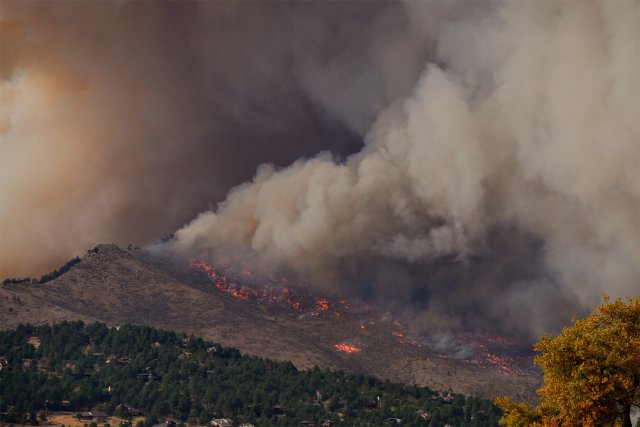Wildfire Smoke Readiness and Response for Region 10 Tribes
The following resources are available to help support Tribes in managing the effects of wildfire smoke on Tribal lands in Alaska, Idaho, Oregon and Washington (EPA's Region 10).

On this page:
- Find real-time data
- Outreach and keeping people safe
- Schools and children’s health
- Extreme heat and smoke
- Wildfire prevention and safety
- Community groups
- Air quality sensors
- Wildfire research
- Contacts
Find real-time data
- AirNow fire and smoke map – Find PM2.5 levels, named fire locations, smoke plumes, and links to Interagency Wildland Fire Air Quality Response Program reports during wildfire events. Data from the EPA and U.S. Forest Service.
- AirNow Air Quality Index – Find current air quality data and recommendations for how to stay safe during different categories of air pollution.
- AirNow wildfires – Learn what to do before, during, and after smoke events.
- Current EPA burn bans and air quality advisories for reservations in Oregon, Idaho, and Washington.
Regional smoke blogs
Blogs maintained by states and agencies to provide current smoke and air quality information and health recommendations.
- Alaska wildland fire information
- Idaho smoke information
- Oregon smoke information
- Washington smoke information
- FireSmoke Canada
Outreach and keeping people safe
- Smoke-Ready Toolbox for Wildfires – Smoke readiness, health resources, and information about how to reduce your exposure to smoke.
- Smoke Ready - Interagency Wildfire Air Quality Response Program – A compilation of information on smoke readiness.
- Wildfire Safety Social Media Toolkit – FEMA's safety and preparedness messages for social media.
- Wildfire Smoke: A Guide for Public Health Officials – AirNow information on health effects of smoke, air quality impacts, and strategies for reducing exposure.
- Coping with the stress of wildfire smoke – Printable resource from EPA's AirNow.
- Protect your pets from wildfire smoke and protect your large animals and livestock from wildfire smoke – Printable resources from EPA's AirNow.
Indoor air quality
- Wildfires and indoor air quality – EPA information to reduce your exposure to wildfire smoke inside your home.
- Create a "clean room" – EPA information about setting up a clean room in your house.
- Air cleaners and air filters in the home – EPA guide for selecting an air cleaner for your space.
- Let’s Clear the Air: Protect Yourself from Wildfire Smoke (YouTube) – Video by Aleknagik Traditional Council and Alaska partners.
Do-it-yourself air cleaners
- How to Make Your Own Clean Air Fan (YouTube) – Video from Washington Dept. of Ecology using one filter and a box fan.
- Box Fan Filter DIY Users Guide (YouTube) – Video from Colville Tribes using two filters and a box fan.
Schools and children’s health
- Pediatric Environmental Health Specialty Units: Wildfires – PEHSU's website provides information for families to help prevent or reduce exposure to wildfire smoke and ash.
- Protecting Children from Wildfire Smoke and Ash (pdf) – Printable resource from PEHSU.
- Washington Children and Youth Activities Guide for Air Quality (pdf) – Printable resource from Washington Department of Health.
Extreme heat and smoke
- Extreme heat – EPA guidance to prepare for heat events in advance.
- National Integrated Heat Health Information System – A collaboration among federal agencies to provide information about extreme heat.
Wildfire prevention and safety
- Bureau of Indian Affairs wildfire prevention – Education to reduce human caused fires.
- FEMA Ready: wildfires – Advance actions to prevent loss and prepare for evacuation from wildfires.
- U.S. Fire Administration: wildfire outreach materials – Awareness and prevention materials to live safely in the wildland-urban interface.
Community groups
- Firewise USA: residents reducing wildfire risks – Resources available from the National Fire Protection Association, including guidance to establish a group, funding resources, case studies.
- Okanogan Clean Air Smoke Ready Checklist (Washington)
- Ashland Forest Resiliency Stewardship Project (Oregon)
Air quality sensors
- EPA Air Sensor Toolbox – Best practices for use of low-cost sensors, their performance, understanding and displaying data, and links to other information.
- EPA Region 10 Air Sensor Loan Program
- EPA Enhanced Air Sensor Guidebook – Guide to using sensors for scientists, professionals, community groups and individuals, with basics on air quality, pollutants, sensor selection, and data quality.
- EPA Enhanced Air Sensor Guidebook (YouTube): Video companion to the guidebook.
Wildfire research
- USGS fire science – Funds research on wildland fire, maintains a research database supporting policy decisions.
- Northwest Fire Science Consortium (Oregon and Washington) – Promotes the awareness, understanding, and adoption of wildland fire science, supports research, education.
- Northern Rockies Fire Science Network (Idaho) – Events, fire and traditional knowledge (newsletter available).
- U.S. Forest Service fire research
- EPA wildland fire research to protect health and the environment
EPA Region 10 contacts
- Erin McTigue (mctigue.erin@epa.gov), 206-553-1254, Smoke Management Coordinator.
- Sandra Brozusky (brozusky.sandra@epa.gov), 206-553-5317, Tribal Air Team lead.
- Althea Godfrey (godfrey.althea@epa.gov), 206-553-1604, Federal Air Rules for Reservations compliance, burn ban lead.
